Iveco Ford Truck is a major CV manufacturer by any
Page 37
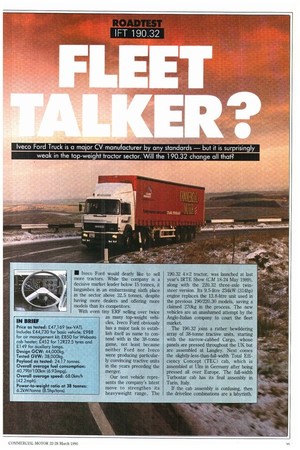
Page 38
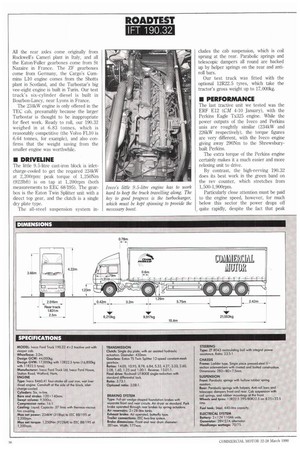
Page 39
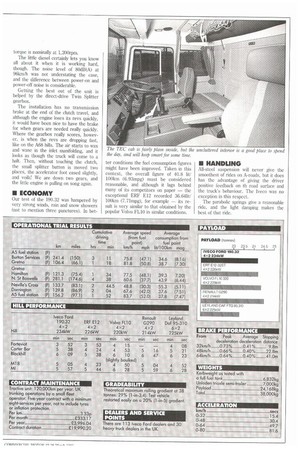
Page 40
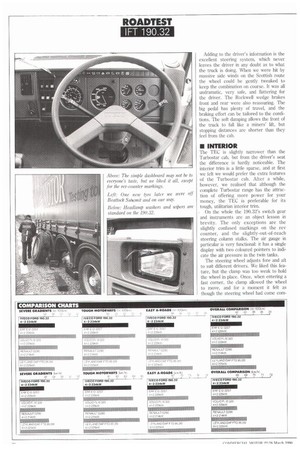
Page 41
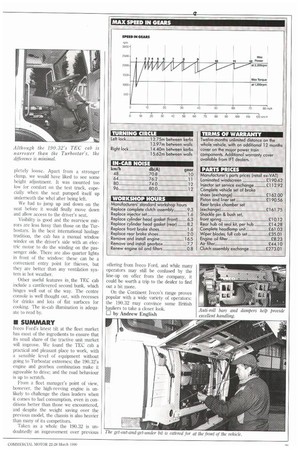
If you've noticed an error in this article please click here to report it so we can fix it.
standards — but it is surprisin. ly weak in the top-weight tractor sector. Will the 190.32 change all that?
• Iveco Ford would dearly like to sell more tractors. While the company is a decisive market leader below 15 tonnes, it languishes in an embarrassing sixth place in the sector above 32.5 tonnes, despite having more dealers and offering more models than its competitors.
With even tiny ERF selling over twice
as many top-weight vehicles, lveco Ford obviously has a major task to establish itself as name to contend with in the 38-tonne game, not least because neither Ford nor Iveco were producing particularly convincing tractive units in the years preceding the merger.
Our test vehicle represents the company's latest move to strengthen its heavyweight range. The
190.32 4x2 tractor, was launched at last year's 1RTE Show (CM 18-24 May 1989), along with the 220.32 three-axle twinsteer version. Its 9.5-litre 234kW (314hp) engine replaces the 13.8-litre unit used in the previous 190/220.30 models, saving a claimed 270kg in the process. The new vehicles are an unashamed attempt by the Anglo-Italian company to court the fleet market.
The 190.32 joins a rather bewildering array of 38-tonne tractive units, starting with the narrow-cabbed Cargo, whose panels are pressed throughout the UK but are assembled at Langley. Next comes the slightly-less-than-full-width Total Efficiency Concept (TEC) cab, which is assembled at Ulm in Germany after being pressed all over Europe. The full-width Turbostar cab has its final assembly in Turin, Italy.
If the cab assembly is confusing, then the driveline combinations are a labyrinth.
All the rear axles come originally from Rockwell's Cameri plant in Italy, and all the Eaton/Fuller gearboxes come from St Nazaire in France. The ZF gearboxes come from Germany, the Cargo's Cummins LIO engine comes from the Shotts plant in Scotland, and the Turbostar's big vee-eight engine is built in Turin. Our test truck's six-cylinder diesel is built in Bourbon-Lancy, near Lyons in France.
The 234kW engine is only offered in the TEC cab, presumably because the larger Turbostar is thought to be inappropriate for fleet work. Ready to roll, our 190.32 weighed in at 6.83 tonnes, which is reasonably competitive (the Volvo FL10 is 6.64 tonnes, for example), and also confirms that the weight saving from the smaller engine was worthwhile.
• DMVELINE
The little 9.5-litre cast-iron block is inletcharge-cooled to get the required 234kW at 2,200rpm: peak torque of 1,250Nm (9221bft) is on tap at 1,200rpm (both measurements to EEC 68/195). The gearbox is the Eaton Twin Splitter unit with a direct top gear, and the clutch is a single dry plate type.
The all-steel suspension system in dudes the cab suspension, which is coil sprung at the rear. Parabolic springs and telescopic dampers all round are backed up by helper springs on the rear and antiroll bars.
Our test truck was fitted with the optional 12R22.5 tyres, which take the tractor's gross weight up to 17,000kg.
• PERFORMANCE
The last tractive unit we tested was the ERF E12 (CM 4-10 January), with the Perkins Eagle Tx325 engine. While the power outputs of the Iveco and Perkins unis are roughtly similar (234kW and 226kW respectively), the torque figures are very different, with the Iveco engine giving away 290Nm to the Shrewsburybuilt Perkins.
The extra torque of the Perkins engine certainly makes it a much easier and more relaxing unit to drive.
By contrast, the high-revving 190.32 does its best work in the green band on the rev counter, which stretches from 1,500-1,900rpm.
Particularly close attention must be paid to the engine speed, however, for much below this sector the power drops off , quite rapidly, despite the fact that peak torque is nominally at 1,200rpm.
The little diesel certainly lets you know all about it when it is working hard, though. The noise level of 80dB(A) at 96km/h was not understating the case, and the difference between power-on and power-off noise is considerable, Getting the best out of the unit is helped by the direct-drive Twin Splitter gearbox.
The installation has no transmission brake at the end of the clutch travel, and although the engine loses its revs quickly, it would have been nice to have the brake for when gears are needed really quickly. Where the gearbox really scores, however, is when the revs are dropping fast, like on the A68 hills. The air starts to wax and wane in the inlet manifolding, and it looks as though the truck will come to a halt. Then, without touching the clutch, the small splitter button is moved two places, the accelerator foot eased slightly, and voila! We are down two gears, and the little engine is pulling on song again.
• ECONOMY
Our test of the 190.32 was hampered by very strong winds, rain and snow showers (not to mention three punctures). In bet ter conditions the fuel consumption figures might have been improved. Taken in this context, the overall figure of 40.8 lit/ 100km (6.93mpg) must be considered reasonable, and although it lags behind many of its competitors on paper the exceptional ERF E12 recorded 36.641it/ 100km (7.71mpg), for example its result is very similar to that obtained by the popular Volvo FLIO in similar conditions.
II HANDLING
All-steel suspension will never give the smoothest of rides on A-roads, but it does has the advantage of giving the driver positive feedback on th road surface and the truck's behaviour. The Iveco was no exception in this respect.
The parabolic springs give a reasonable ride, and the light damping makes the best of that ride. Adding to the driver's information is the excellent steering system, which never leaves the driver in any doubt as to what the truck is doing. When we were hit by massive side winds on the Scottish route the wheel could be gently tweaked to keep the combination on course. It was all undramatic, very safe, and flattering for the driver. The Rockwell wedge brakes front and rear were also reassuring. The big pedal has plenty of travel, and the braking effort can be tailored to the conditions. The soft damping allows the front of the truck to fall like a miners' lift, but stopping distances are shorter than they feel from the cab.
• INTERIOR
The TEC is slightly narrower than the Turbostar cab, but from the driver's seat the difference is hardly noticeable. The interior trim is a little sparse, and at first we felt we would prefer the extra features of the Turbostar cab. After a while, however, we realised that although the complete Turbostar range has the attraction of offering more power for your money, the 'FEC is preferable for its tough, utilitarian interior trim.
, On the whole the 190.32's switch gear and instruments are an object lesson in brevity. The only exceptions are the slightly confused markings on the rev counter, and the slightly-out-of-reach steering column stalks. The air gauge in particular is very functional: it has a single display with two coloured pointers to indicate the air pressure in the twin tanks.
The steering wheel adjusts fore and aft to suit different drivers. We liked this feature, but the clamp was too weak to hold the wheel in place. Once, when entering a fast corner, the clamp allowed the wheel to move, and for a moment it felt as though the steering wheel had come corn pletely loose. Apart from a stronger clamp, we would have liked to see some height adjustment. It was mounted too low for comfort on the test truck, especially when the seat pumped itself up underneath the whel after being left.
We had to jump up and down on the seat before it would finally move down and allow access to the driver's seat.
Visibility is good and the rearview mirrors are less fussy than those on the Turhostars. In the best international haulage tradition, the cab has a manual window winder on the driver's side with an electric motor to do the winding on the passenger side. There are also quarter lights in front of the window: these can be a convenient entry point for thieves, but they are better than any ventilation system in hot weather.
Other useful features in, the TEC cab include a cantilevered second bunk, which hinges well out of the way. The centre console is well thought out, with recesses for drinks and lots of flat surfaces for cooking. The in-cab illumination is adequate to read by.
• SUMMARY
Iveco Ford's latest tilt at the fleet market has most of the ingredients to ensure that its small share of the tractive unit market will improve. We found the TEC cab a practical and pleasant place to work, with a sensible level of equipment without going to Turbostar extremes; the 190.32's engine and gearbox combination make it agreeable to drive; and the road behaviour is up to scratch.
From a fleet manager's point of view, however, the high-revving engine is unlikely to challenge the class leaders when it comes to fuel consumption, even in condilions better than those we encountered, and despite the weight saving over the previous model, the chassis is also heavier than many of its competitors.
Taken as a whole the 190.32 is undoubtedly an improvement over previous offering from Iveco Ford, and while many operators may still be confused by the line-up on offer from the company, it could be worth a trip to the dealer to find out a bit more.
On the Continent Iveco's range proves popular with a wide variety of operators: the 190.32 may convince some British hauliers to take a closer look.
ID by Andrew English








































































































